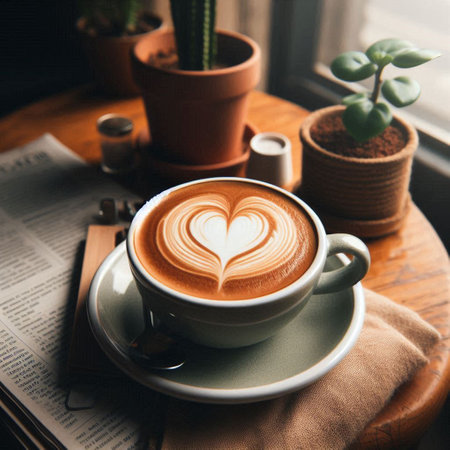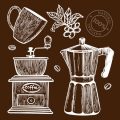1. The Roots of British Coffee Culture
For centuries, the quintessential British beverage has been tea—an emblem of comfort, tradition, and social ritual. From afternoon teas in stately homes to the humble builders brew enjoyed on building sites across the nation, tea has long defined British identity. However, coffee’s journey into the British mainstream has been a slow yet persistent evolution. The earliest coffee houses appeared in London during the 17th century, serving as lively hubs for intellectual debate and commerce. Yet, despite this promising start, coffee never quite rivalled tea’s dominance, which was cemented by the rise of the British Empire and its global tea trade. It wasn’t until the late 20th and early 21st centuries—with the advent of high street coffee chains and a new generation of independent roasters—that coffee began to claim a significant place in everyday British life. Today, ordering a flat white is as common as asking for a strong cuppa, signalling not just a shift in taste but also a transformation in the language and culture surrounding hot drinks in Britain.
2. Builders Brew: The Working-Class Cuppa
The term ‘builder’s brew’ is deeply rooted in British working-class culture, symbolising a straightforward, no-nonsense approach to hot beverages. Unlike the artisan coffees that have recently gained popularity, a builder’s brew refers to a robust cup of tea—strong, with plenty of milk and sugar, brewed to sustain manual labourers through long shifts. This humble cuppa has become an emblem of camaraderie and practicality on building sites across the UK.
The Cultural Significance
Builder’s brew is more than just a drink; it represents the social glue binding British workforces together. Sharing a round of tea on-site is both a ritual and an unspoken contract—a mark of respect among colleagues and a way to foster solidarity during hard graft. Its simplicity stands in stark contrast to the complexities of modern coffee culture, serving as a reminder of Britain’s enduring relationship with tea as an everyday essential rather than a luxury.
Influence on Beverage Preferences
The legacy of the builder’s brew has shaped British attitudes towards all hot beverages, setting expectations for strength, warmth, and comfort over sophistication or trendiness. When contemporary coffee terminology began filtering into British society, many initially met it with scepticism. Yet the influence of the builder’s brew ensured that even new drinks had to meet certain standards for heartiness and satisfaction. The table below highlights key differences between a traditional builder’s brew and contemporary coffee options:
| Beverage | Typical Ingredients | Strength | Cultural Connotation |
|---|---|---|---|
| Builder’s Brew | Black tea, milk, sugar | Very strong | Practicality, camaraderie |
| Flat White | Espresso, steamed milk | Medium-strong | Modernity, craft |
| Cappuccino | Espresso, frothed milk | Mild-medium | Continental sophistication |
The Enduring Legacy
The builder’s brew continues to be referenced in British popular culture and workplace banter. It reminds us that while the nation’s coffee language may evolve, the foundational values—community, reliability, and substance—remain steadfastly British. Whether you’re sipping tea from a battered mug or sampling a trendy flat white, echoes of the builder’s brew persist in every cup poured across the UK.

3. Continental Influence: Espressos, Lattes, and the Rise of Café Culture
As Britain stepped into the late 20th century, its coffee language underwent a profound transformation under the influence of continental Europe. The Italian espresso bar model began to infiltrate British high streets, introducing a lexicon previously unfamiliar to the average tea-drinking Brit. Suddenly, terms like “espresso,” “latte,” and “cappuccino” became staples not only on menus but also in everyday conversation. This shift was not merely about taste; it marked an evolution in how Britons approached social interaction and urban leisure.
The growth of independent coffee shops played a pivotal role in this cultural exchange. These establishments, inspired by the bustling cafés of Paris and Milan, fostered a new sense of community and creative energy. Unlike the utilitarian function of builder’s brew or instant coffee, these spaces encouraged patrons to linger over their drinks, discuss ideas, or simply watch the world go by. The espresso-based beverages, each with their own preparation techniques and flavour profiles, brought an artisan touch that resonated with a generation seeking both quality and authenticity.
This continental wave also influenced the language around coffee itself. Words like “single origin,” “ristretto,” and “macchiato” started appearing alongside traditional British terms, reflecting both curiosity and a growing sophistication among consumers. For many, learning how to order a flat white or deciphering the difference between a cortado and a piccolo became part of the daily ritual—a signifier of cultural awareness as much as personal preference.
The impact was more than linguistic. The arrival of European-style cafés contributed to an architectural and social renaissance in cities like London, Manchester, and Edinburgh. Vacant storefronts transformed into vibrant hubs where independent roasters showcased their craft, further embedding these foreign terms into Britain’s modern vernacular. As a result, café culture began to rival that of European capitals, blending tradition with innovation in uniquely British ways.
4. The Flat White Revolution
Few beverages have disrupted the British coffee scene quite like the flat white. Originating from Australia and New Zealand, the flat white entered the UK around the mid-2000s and rapidly became a mainstay in coffee shops from London to Leeds. Technically speaking, the flat white offers a unique milk-to-espresso ratio and textural profile that distinguishes it from traditional British favourites like the cappuccino or latte.
The Technical Anatomy of a Flat White
At its core, the flat white is defined by its balance—typically crafted with a double shot of espresso and topped with microfoam (finely textured steamed milk), resulting in a smaller, stronger, and silkier drink compared to its Italian cousins. Below is a comparative table illustrating key differences:
| Beverage | Espresso Shots | Milk Texture | Volume (ml) | Key Feature |
|---|---|---|---|---|
| Flat White | 2 | Microfoam | 150–180 | Smooth, velvety texture; strong espresso flavour |
| Cappuccino | 1–2 | Frothy foam | 180–200 | Thick foam layer; balanced milk and espresso |
| Latte | 1–2 | Steamed milk with light foam | 200–300 | Mild flavour; larger milk content |
Cultural Integration into British Coffee Language
The assimilation of the flat white into everyday vernacular marked a turning point in how Britons discussed and consumed coffee. No longer was ordering simply about “white” or “black” coffee; consumers began requesting specific drinks by name, reflecting both an increased technical awareness and a desire for personalisation. Cafés across the UK adapted swiftly, training baristas in precise milk steaming techniques and promoting the flat white as an artisanal alternative to classic offerings.
The Flat White’s Role in Shaping British Coffee Identity
This shift was not merely about taste but also about identity. The flat white came to symbolise a new era of sophistication within Britain’s café culture—a move away from builder’s brew pragmatism towards a more nuanced appreciation for origin, craft, and experience. Today, asking for a flat white is as much about participating in contemporary British culture as it is about enjoying a well-balanced cup.
5. Language and Identity: How Britain Orders Its Coffee
The language of coffee in the UK has become a subtle, yet telling, marker of personal and social identity. Once, a simple “white coffee” or “black coffee” sufficed in most British cafes. Now, the way one orders coffee is not only a reflection of taste but also of familiarity with global trends and local preferences. Opting for a “flat white,” for instance, signals an awareness of Antipodean café culture—now seamlessly woven into the British coffee lexicon. Meanwhile, asking for a “builder’s brew” at a traditional greasy spoon still carries connotations of working-class roots and no-nonsense practicality.
The Social Semiotics of Coffee Orders
In Britain, coffee order terminology has evolved into a form of social shorthand. The choice between an Americano and a cortado can suggest cosmopolitan leanings or an appreciation for minimalist tradition. A request for oat milk or a “skinny latte” might hint at health-consciousness or alignment with contemporary dietary trends. Even the pronunciation—whether you say “espresso” with an exaggerated Italian flair or stick to the understated British “expresso”—can mark you as either an insider or outsider within certain social groups.
Regional Nuances and Urban Influence
London’s thriving specialty coffee scene has popularised terms like “batch brew” and “V60,” while in smaller towns, more classic terminology often prevails. Regional identities persist: ordering a “milky coffee” in Yorkshire may yield puzzled looks in East London’s hipster cafés. Yet, as national chains expand and independent baristas experiment, the vocabulary continues to blend, reflecting both local pride and international influence.
Your Order, Your Statement
Ultimately, what you ask for at the counter is more than a drink—it is a statement about your place in modern British society. Whether embracing innovation with a nitro cold brew or sticking to tradition with instant granules, Britons use coffee language to navigate belonging and individuality alike. The evolution from builder’s brew to flat white encapsulates not just changing tastes, but the ongoing negotiation between heritage and cosmopolitanism that defines Britain’s contemporary coffee culture.
6. From Spoons to Speciality: Navigating Modern British Coffee
In the final act of Britains coffee evolution, the journey from ubiquitous high street chains to the rise of independent artisan roasters marks a significant cultural and linguistic shift. The familiar comfort of “Spoons”—the affectionate shorthand for Wetherspoon pubs—once defined the everyday coffee experience for many Britons. Here, coffee was straightforward: served hot, strong, and unadorned, a companion to a full English or a late-night catch-up. Yet, as cosmopolitan influences seeped into British cities and towns, the language around coffee evolved in tandem with changing tastes.
The arrival of international chains like Costa, Caffè Nero, and Starbucks brought with them an espresso-led menu and a new lexicon. Suddenly, ordering a “latte” or “cappuccino” became standard practice, even if initial confusion over cup sizes and syrup shots abounded. These high street giants democratised the café experience but also sparked debates about authenticity versus convenience—a flat white might have made its way from Australia via London’s Soho, but was it truly the same when mass-produced?
Amidst this backdrop, a new wave of speciality coffee roasters began carving out space on Britain’s urban map. Independent cafes in Brighton, Manchester, Bristol, and beyond championed single-origin beans, meticulously dialled-in espresso shots, and hand-poured filter brews. The language here shifted again: baristas spoke of “extraction time,” “brew ratios,” and “cupping notes.” Customers learned to distinguish between washed Ethiopian Yirgacheffe and natural-processed Brazilian coffees—terms that would have mystified a builder in need of his morning mug.
The Authenticity Debate
Yet with progress came debate. Purists questioned whether chains could ever deliver genuine coffee quality or if true craftsmanship resided only in small-batch roasteries. Some saw the emergence of latte art and tasting menus as elitist, others as evidence of a maturing national palate. For every critic lamenting the loss of straightforwardness (“Just give us a proper brew!”), there was an advocate celebrating choice and traceability.
The British Coffee Identity Today
What emerges is not a clear winner in the battle for authenticity but rather a uniquely British blend—where one can still find builders at greasy spoons sipping instant alongside students discussing fruity acidity at their local indie café. The vocabulary continues to grow; words like “third wave” and “micro-lot” now sit comfortably alongside “white with two sugars.”
A Continuing Conversation
Britain’s coffee language reflects its broader social changes: globalisation, regional pride, nostalgia for tradition, and curiosity for innovation. Whether you’re loyal to your local chain or passionate about pour-overs from your neighbourhood roastery, navigating modern British coffee means understanding both where we’ve come from—and where we’re headed next.


